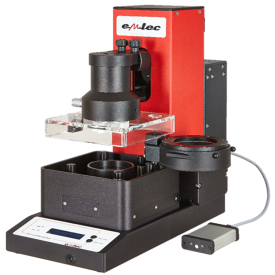
Fabric touch tester
The fabric tactile tester simulates the movements of human touch, such as pulling, pressing, pinching, kneading, and rubbing, to test the thickness, bending, compression, friction, and stretching properties of the fabric. It obtains five quantitative indicators of thickness, softness, stiffness, smoothness, and tightness, objectively evaluating the comprehensive tactile style of the fabric.
Applicable scope:
Suitable for general fiber sheet products: clothing fabrics, home textile fabrics, non-woven fabrics, yarns, automotive interiors, leather, paper, etc.
Technical parameters:
1. Sample size: 50 * 500mm;
2. Thickness: 4mm;
3. Test range: 0-80mm;
Testing principle:
Simulating the subjective perception process of human hands on fabrics, all the pressure heads used are cylindrical shapes that vividly simulate human fingers, with fine patterns on them, used to simulate fingerprints. The pressure head also adopts the form of one on top and two on bottom, simulating the process of human touch. The system quantifies the corresponding indicators by conducting physical tests such as compression, bending, friction, and stretching on the material, and obtains the surface compression thickness, softness SF, stiffness ST, smoothness SM, and elasticity LT, thereby evaluating the comprehensive style of the fabric.
1. Thickness indicator, the thickness of the fabric compressed by the curved surface.
2. In the first stage, the surface is compressed to obtain compression modulus, compression deformation, etc., expressed as softness SF.
3. In the second stage, the bending test obtains the bending value, bending modulus, bending work, etc., which are expressed as stiffness ST.
4. In the third stage, the friction test obtains the average friction force, friction coefficient, friction work, etc., and the sliding degree SM.
5. In the fourth stage, the tensile test obtains the tensile modulus, tensile work, etc., which are expressed as the degree of elasticity LT.
Prev: Scott Rubbing Test Machine
Next: Fabric cooling tester